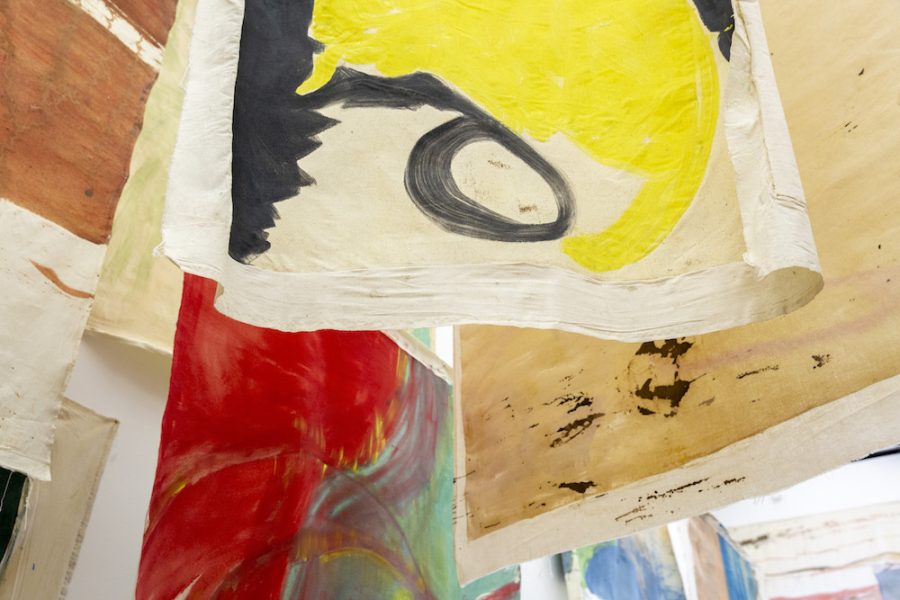
Installation view, Vivian Suter, the Institute of Contemporary Art/Boston, 2019. Photo by Mel Taing © Vivian Suter

Installation view, Vivian Suter, the Institute of Contemporary Art/Boston, 2019. Photo by Mel Taing © Vivian Suter
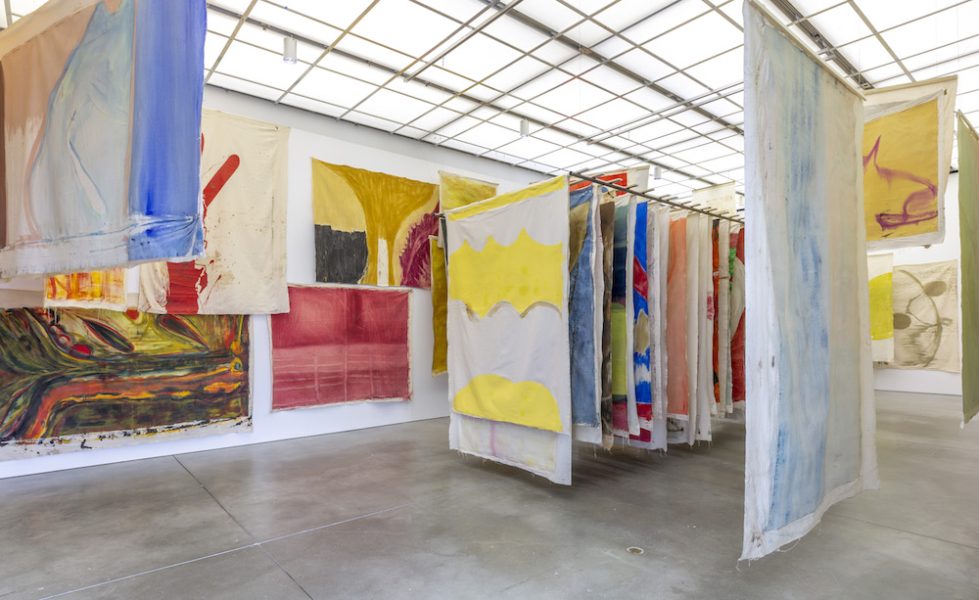
Installation view, Vivian Suter, the Institute of Contemporary Art/Boston, 2019. Photo by Mel Taing © Vivian Suter
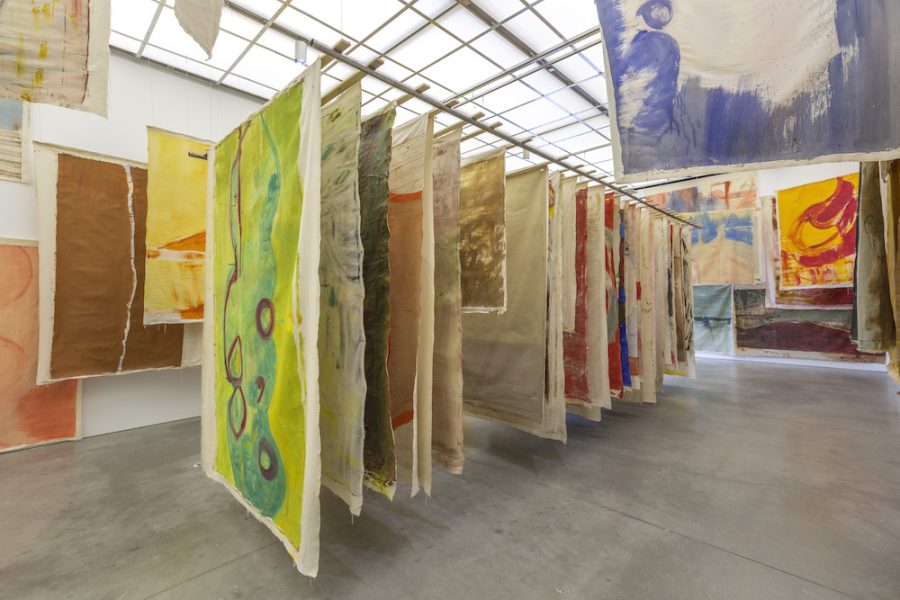
Installation view, Vivian Suter, the Institute of Contemporary Art/Boston, 2019. Photo by Mel Taing. © Vivian Suter
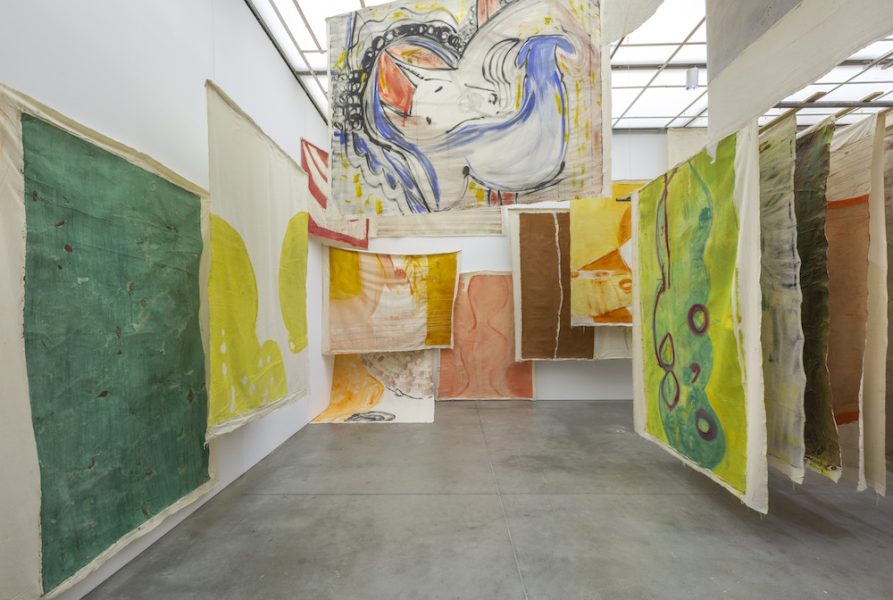
Installation view, Vivian Suter, the Institute of Contemporary Art/Boston, 2019. Photo by Mel Taing © Vivian Suter
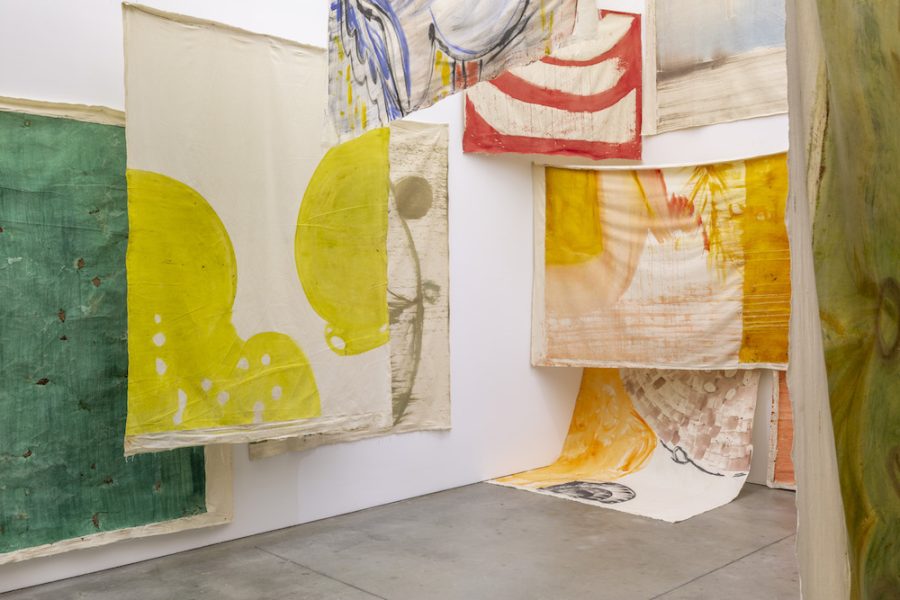
Installation view, Vivian Suter, the Institute of Contemporary Art/Boston, 2019. Photo by Mel Taing © Vivian Suter

Installation view, Vivian Suter, the Institute of Contemporary Art/Boston, 2019. Photo by Mel Taing © Vivian Suter

Installation view, Vivian Suter, the Institute of Contemporary Art/Boston, 2019. Photo by Mel Taing © Vivian Suter

Installation view, Vivian Suter, the Institute of Contemporary Art/Boston, 2019. Photo by Mel Taing. © Vivian Suter

Installation view, Vivian Suter, the Institute of Contemporary Art/Boston, 2019. Photo by Mel Taing © Vivian Suter
Vivian Suter (b. 1949, Buenos Aires, Argentina) works in close partnership with the natural environment surrounding her home and studio in Panajachel, Guatemala. Her method often involves moving her canvases between the indoors and outdoors and exposing them to the climate in order to allow nature to commingle with her broadly painted swaths of vivid color. Inspired by the surrounding vegetation and landscape, Suter’s gestural compositions work in concert with rainfall and mud puddles, with the light that passes between branches and the animals in the forest. A place of tremendous beauty and plant and animal life as well as the rich, indigenous Mayan culture, Panajachel and the area around Lake Atitlán has also witnessed countless disruptions throughout history, from active volcanoes and numerous floods to Spanish colonization and a thirty-six-year civil war that ended in 1996. This installation of layered and suspended canvases invites visitors to discover her unique dialogue with imagined and natural worlds.
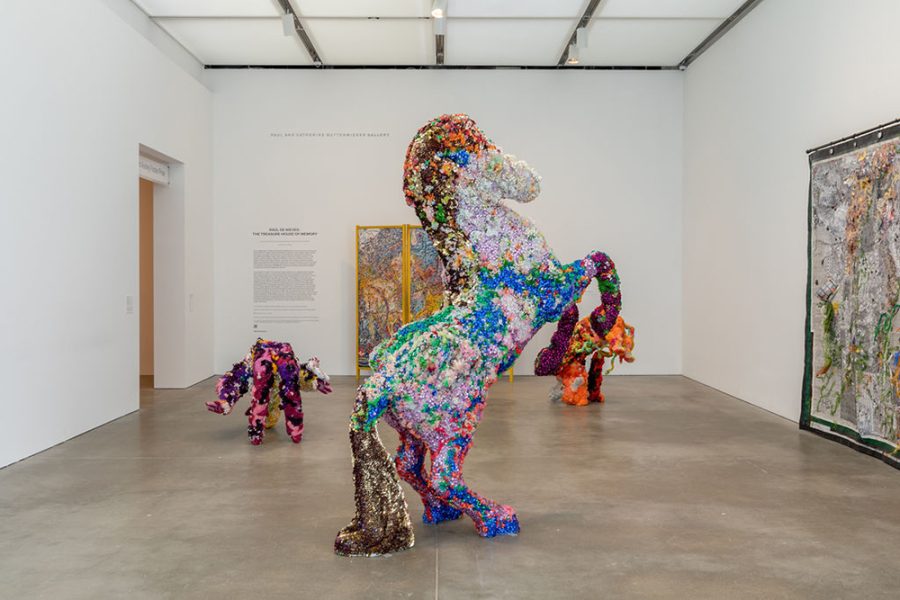
Installation view, Raúl de Nieves: The Treasure House of Memory, the Institute of Contemporary Art/Boston, 2021–22. Photo by Mel Taing.
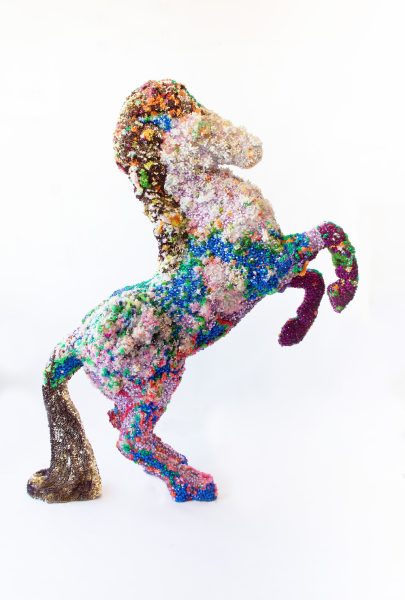
Raúl de Nieves, The Fable, which is composed of wonders, moves the more, 2021. Fiberglass, pla…
View full credits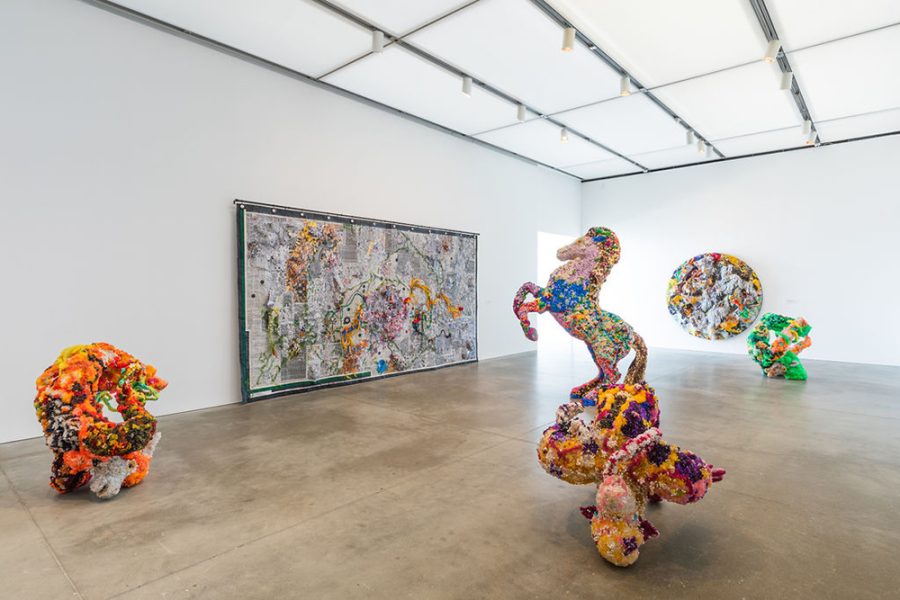
Installation view, Raúl de Nieves: The Treasure House of Memory, the Institute of Contemporary Art/Boston, 2021–22. Photo by Mel Taing.

Installation view, Raúl de Nieves: The Treasure House of Memory, the Institute of Contemporary Art/Boston, 2021–22. Photo by Mel Taing.

Raúl de Nieves, The Fable, which is composed of wonders, moves the more, 2021. Fiberglass, plastic, cultured pearls, metal, glass, glue, and resin. 95 x 29 x 65 inches (241.3 x 74 x 165.1 cm). Courtesy the artist and Company Gallery, New York. © Raúl de Nieves

Installation view, Raúl de Nieves: The Treasure House of Memory, the Institute of Contemporary Art/Boston, 2021–22. Photo by Mel Taing.

Installation view, Raúl de Nieves: The Treasure House of Memory, the Institute of Contemporary Art/Boston, 2021–22. Photo by Mel Taing.
Raúl de Nieves (b. 1983, Michoacán, Mexico) is a New York–based interdisciplinary artist, performer, and musician whose multifaceted practice ranges from stained-glass-style narrative paintings to animated performances, to densely adorned figurative sculptures encrusted with bangles, beads, bells, sequins, and other homespun materials. These opulent, joyful sculptures reference traditional costumes in Mexican culture and modes of dress from drag, ballroom, and queer club cultures, while also evoking religious processional attire and the outfits worn by circus performers. All of his works share a distinctive visual language that draws from Mexican craft traditions, religious iconography, mythology, and folktales to explore the transformational possibilities of adornment and the mutability of sexuality and identity. For the ICA, de Nieves is creating a body of interconnected works rooted in memory and exploring themes of personal transformation. The Treasure House of Memory expands the artist’s inventive adaptation of iconographic traditions inherited from the past through vibrant amalgamations of form and material rendered in an energetic and accessible visual language.
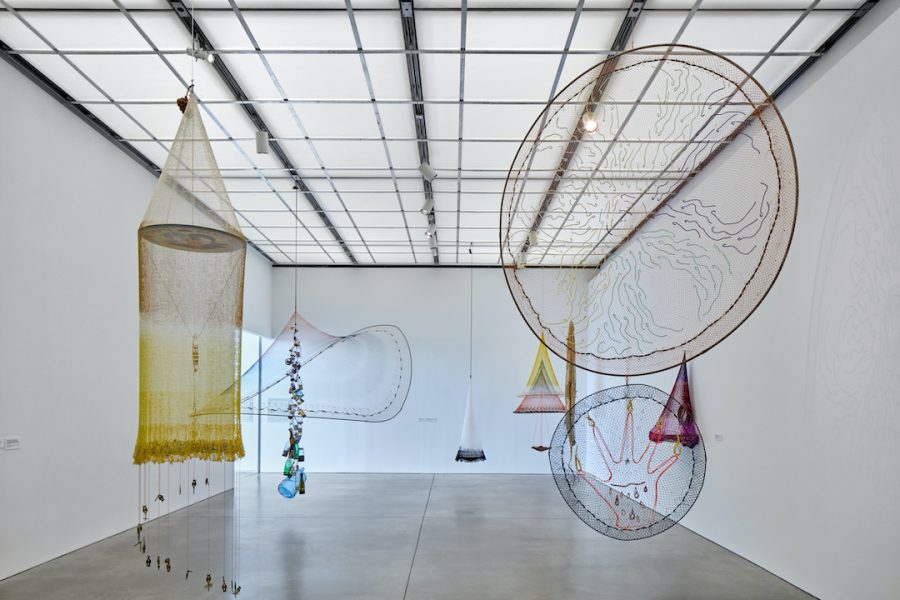
Installation view, Carolina Caycedo: Costmotarrayas, Institute of Contemporary Art/Boston, 2020. Photo by Charles Mayer. Courtesy of the artist. © Carolina Caycedo
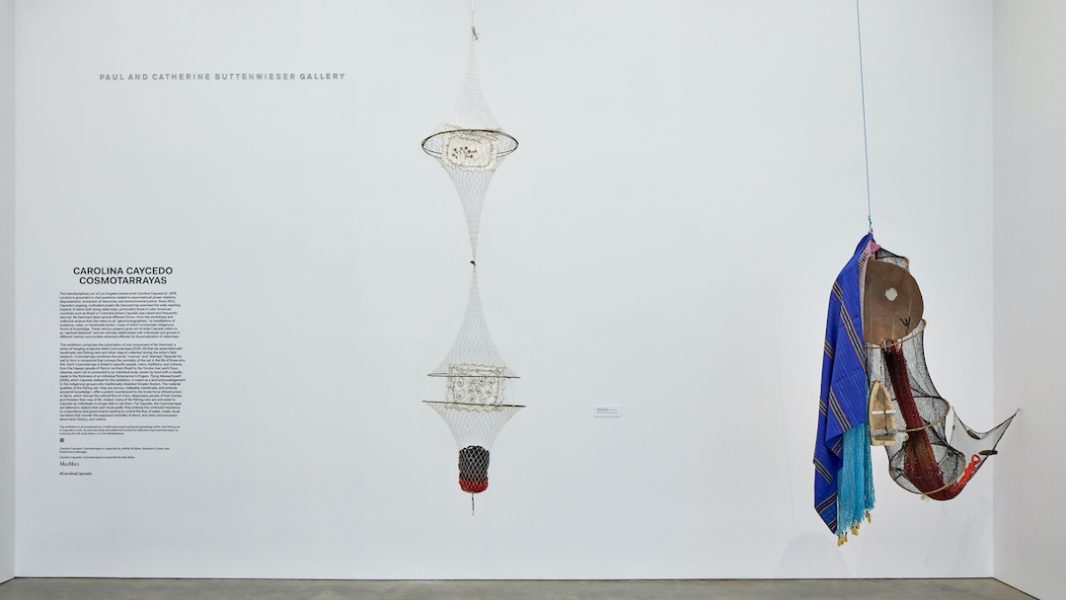
Installation view, Carolina Caycedo: Costmotarrayas, Institute of Contemporary Art/Boston, 2020. Photo by Charles Mayer. Courtesy of the artist. © Carolina Caycedo
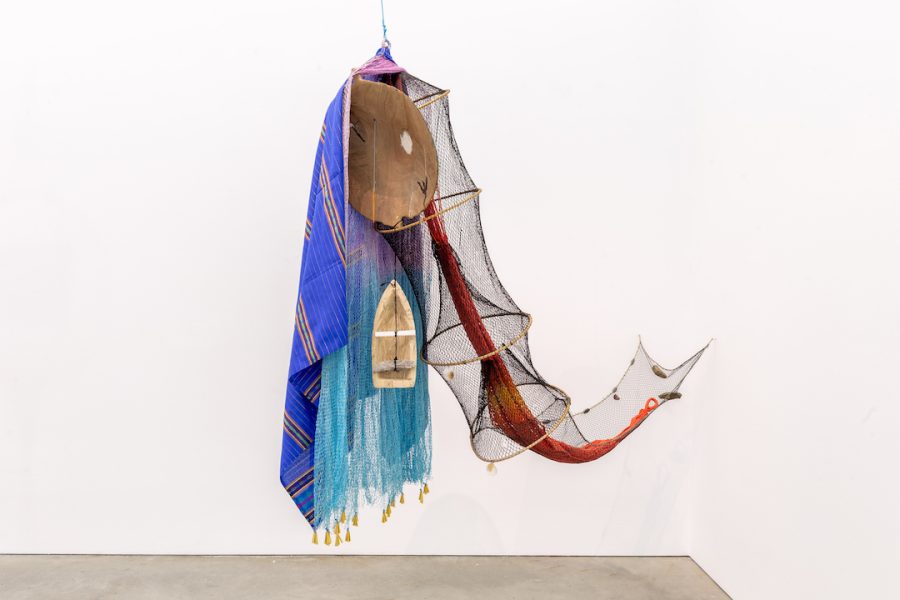
Carolina Caycedo, Flying Massachusett, 2020. Hand-dyed artisanal fishing net, artisanal fishing trap with floaters, hand-dyed artisanal hammock, traditional textile from the Zamboanga Peninsula in the Philippines, hand-carved wooden gold pan, hand-carved wooden boat, white shell, wooden needle, pebbles an…
View full credits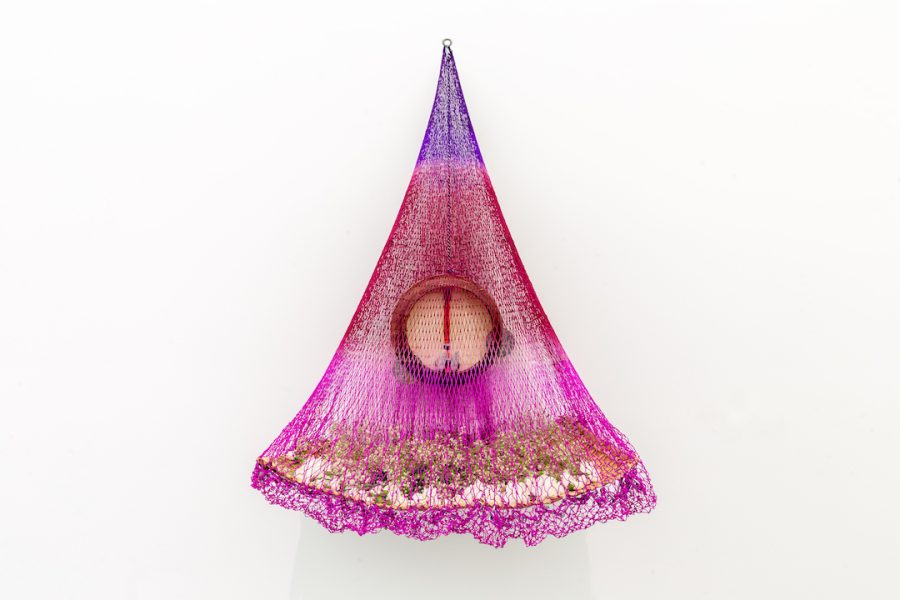
Carolina Caycedo, Nuestro Tiempo/Our Time, 2018. Hand-dyed artisanal fishing net, metal chain, palm mat, wool charm, tambourine, and white flowers 48 x 28 x 18 inches (121. 9 x 11 x 7.1 cm). Installation view, Carolina Caycedo: Cosmotarrayas, Institute of Contemporary Art/Boston, 2020. Collection of Tim an…
View full credits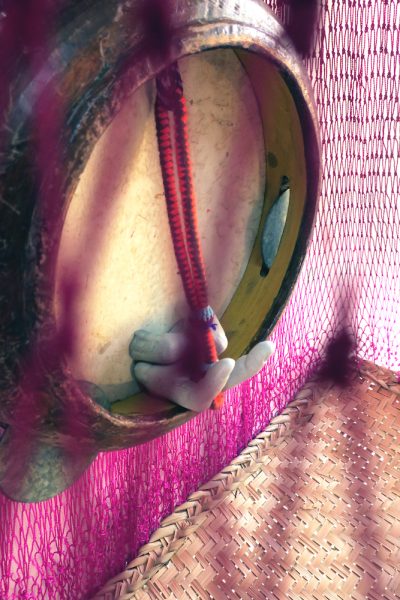
Carolina Caycedo, Nuestro Tiempo/ Our Time, 2018. Hand-dyed artisanal fishing net, metal chain, palm mat, wool charm, and tambourine, 48 x 28 x 18 inches (121. 9 x 11 x 7.1 cm). Private collection, Los Angeles. © Carolina Caycedo
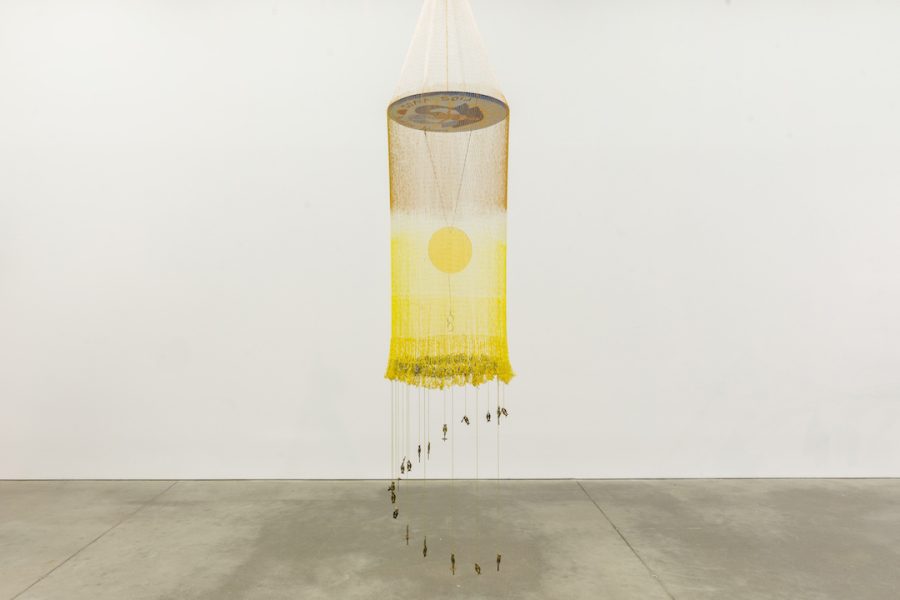
Carolina Caycedo, Ósun, 2018. Hand-dyed artisanal fishing net, steel chain, steel pot lid, mirror, enamel, spray paint, hoop earrings, paracord, string, and brass handles 120 x 24 x 24 inches (304.8 x 61 x 61 cm). Installation view, Carolina Caycedo: Cosmotarrayas, Institute of Contemporary Art/Boston, 2020.&…
View full credits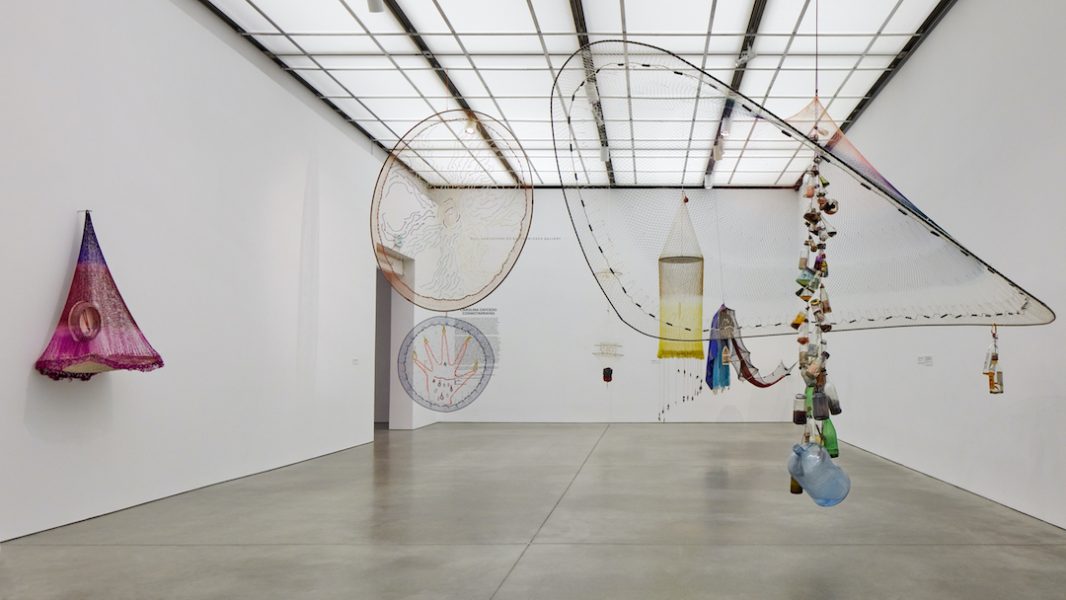
Installation view, Carolina Caycedo: Costmotarrayas, Institute of Contemporary Art/Boston, 2020. Photo by Charles Mayer. Courtesy of the artist. © Carolina Caycedo
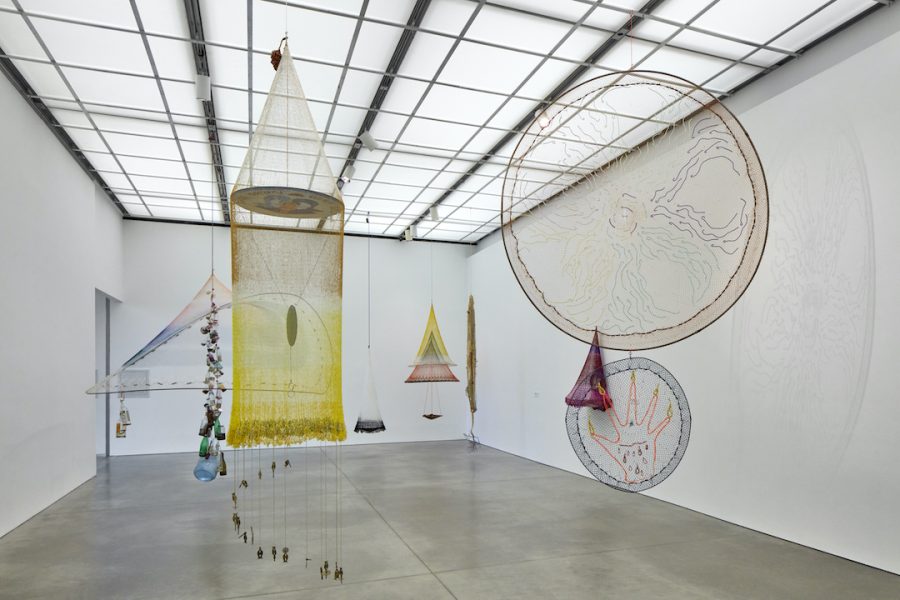
Installation view, Carolina Caycedo: Costmotarrayas, Institute of Contemporary Art/Boston, 2020. Photo by Charles Mayer. Courtesy of the artist. © Carolina Caycedo
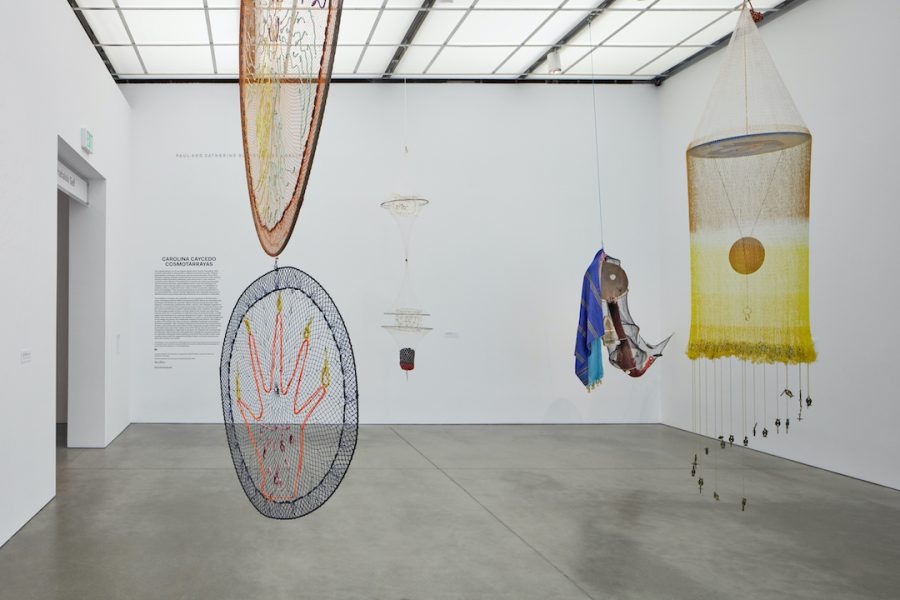
Installation view, Carolina Caycedo: Costmotarrayas, Institute of Contemporary Art/Boston, 2020. Photo by Charles Mayer. Courtesy of the artist. © Carolina Caycedo
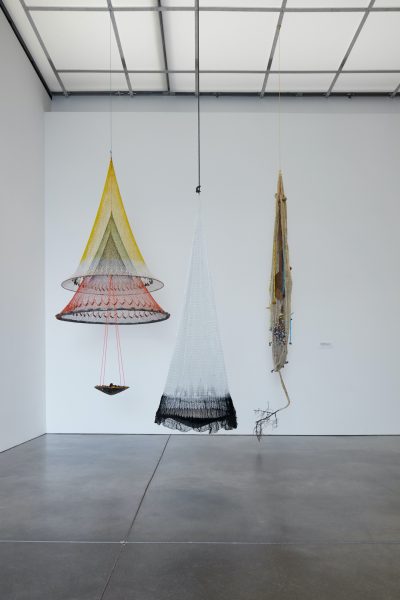
Installation view, Carolina Caycedo: Costmotarrayas, Institute of Contemporary Art/…
View full credits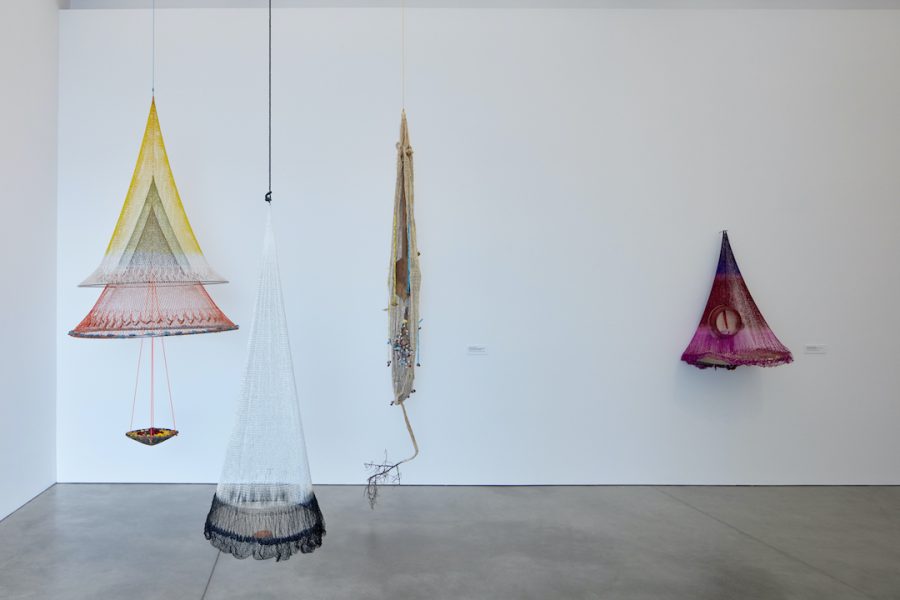
Installation view, Carolina Caycedo: Costmotarrayas, Institute of Contemporary Art/Boston, 2020. Photo by Charles Mayer. Courtesy of the artist. © Carolina Caycedo
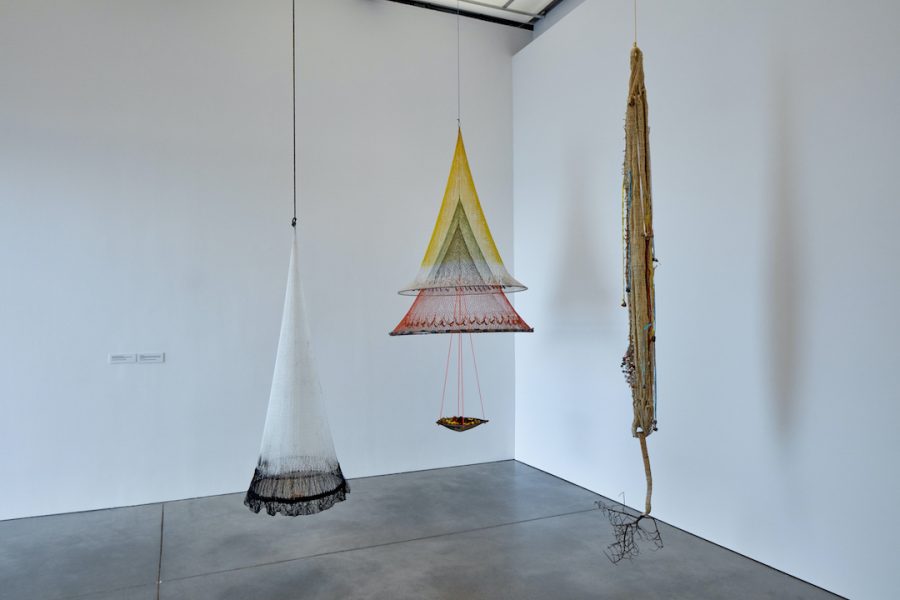
Installation view, Carolina Caycedo: Costmotarrayas, Institute of Contemporary Art/Boston, 2020. Photo by Charles Mayer. Courtesy of the artist. © Carolina Caycedo
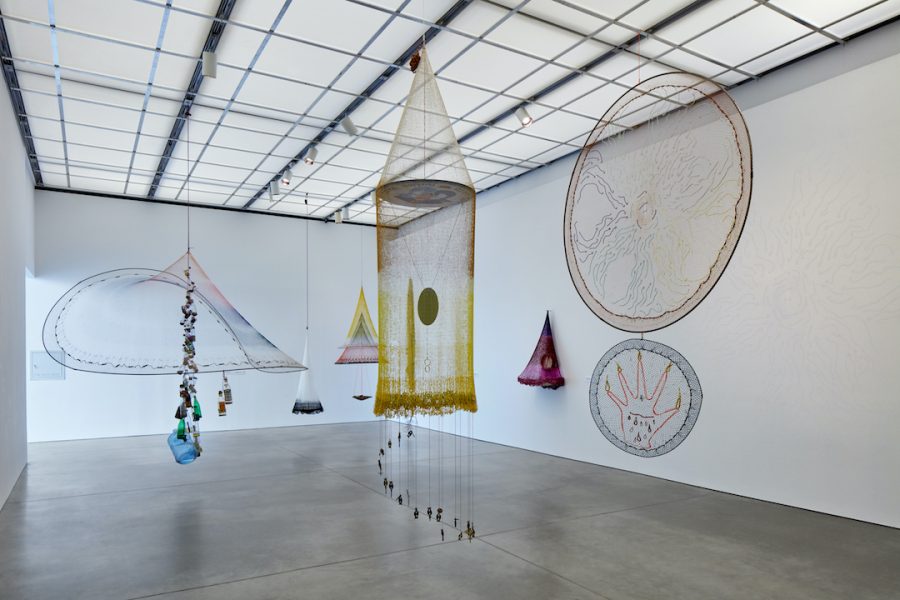
Installation view, Carolina Caycedo: Costmotarrayas, Institute of Contemporary Art/Boston, 2020. Photo by Charles Mayer. Courtesy of the artist. © Carolina Caycedo

Installation view, Carolina Caycedo: Costmotarrayas, Institute of Contemporary Art/Boston, 2020. Photo by Charles Mayer. Courtesy of the artist. © Carolina Caycedo

Installation view, Carolina Caycedo: Costmotarrayas, Institute of Contemporary Art/Boston, 2020. Photo by Charles Mayer. Courtesy of the artist. © Carolina Caycedo

Carolina Caycedo, Flying Massachusett, 2020. Hand-dyed artisanal fishing net, artisanal fishing trap with floaters, hand-dyed artisanal hammock, traditional textile from the Zamboanga Peninsula in the Philippines, hand-carved wooden gold pan, hand-carved wooden boat, white shell, wooden needle, pebbles an…
View full credits
Carolina Caycedo, Nuestro Tiempo/Our Time, 2018. Hand-dyed artisanal fishing net, metal chain, palm mat, wool charm, tambourine, and white flowers 48 x 28 x 18 inches (121. 9 x 11 x 7.1 cm). Installation view, Carolina Caycedo: Cosmotarrayas, Institute of Contemporary Art/Boston, 2020. Collection of Tim an…
View full creditsThe interdisciplinary practice of Los Angeles–based artist Carolina Caycedo (b. 1978, London) is grounded in vital questions related to asymmetrical power relations, dispossession, extraction of resources, and environmental justice.
Since 2012, Caycedo has conducted an ongoing project, Be Dammed, examining the wide-reaching impacts of dams built along waterways by transnational corporations, including the displacement and dispossession of peoples, particularly in Latin American countries such as Brazil or Colombia (where she was raised and frequently returns).
At the ICA, Caycedo will present the culmination of one component of the project, a series of hanging sculptures called Cosmotarrayas that are assembled with handmade fishing nets and other objects collected during field research in river communities affected by the privatization of waterways. These objects, many of which were entrusted to her by individuals no longer able to use them, demonstrate the meaningful connectivity and exchange at the heart of Caycedo’s practice. At the same time, they also represent the dispossession of these individuals and their continued resistance to corporations and governments seeking to control the flow of water and thus their way of life.
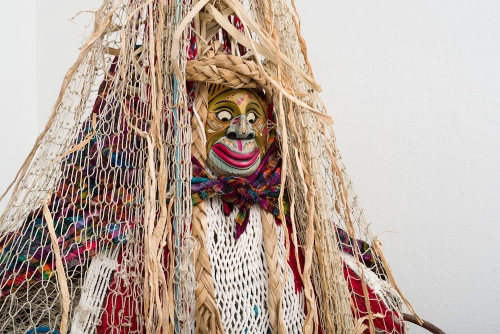
The interdisciplinary art of Los Angeles-based artist Carolina Caycedo (b. 1978, London) is grounded in vital questions related to asymmetrical power relations, dispossession, extraction of resources, and environmental justice. Since 2012, Caycedo’s ongoing, multivalent project Be Dammed has examined the wide-reaching impacts of dams built along waterways, particularly those in Latin American countries such as Brazil or Colombia (where Caycedo was raised and frequently returns). Be Dammed takes several different forms—from the workshops and collective actions that she refers to as “geochoreographies,” to installations of sculpture, video, or handmade books—many of which incorporate indigenous forms of knowledge. These various projects grow out of what Caycedo refers to as “spiritual fieldwork” and her intimate relationships with individuals and groups in different riverine communities adversely affected by the privatization of waterways.
This exhibition comprises the culmination of one component of Be Dammed, a series of hanging sculptures titled Cosmotarrayas (2016–20) that are assembled with handmade cast fishing nets and other objects collected during the artist’s field research. Cosmotarraya combines the words “cosmos” and “atarraya” (Spanish for net) to form a compound that conveys the centrality of the net in the life of those who fish. Each Cosmotarraya is linked to specific people, rivers, traditions, and cultures, from the Kayapo people of Pará in northern Brazil to the Yoruba river spirit Ósun. Likewise, each net is connected to an individual body, woven by hand with a needle made to the thickness of an individual fisherperson’s fingers. Flying Massachusett (2020), which Caycedo realized for this exhibition, is meant as a land acknowledgement to the indigenous groups who traditionally inhabited Greater Boston. The material qualities of the fishing net—they are porous, malleable, handmade, and embody ancestral knowledge—offer a potent counterpoint to the brute-force infrastructure of dams, which disrupt the natural flow of rivers, dispossess people of their homes, and threaten their way of life. Indeed, many of the fishing nets are entrusted to Caycedo by individuals no longer able to use them. For Caycedo, the Cosmotarrayas are talismanic objects that cast visual spells: they embody the continued resistance to corporations and governments seeking to control the flow of water, create visual narratives that counter the supposed neutrality of dams, and raise consciousness about land, history, and culture.
Cosmotarrafa Ver-o-peso, 2016
Hand-dyed fishing nets with iron rings, embroidered cotton fabric, dyed cotton rope, and stic
Collection of Tracy O’Brien and Thaddeus Stauber, Los Angeles
Flying Massachusett, 2020
Hand-dyed artisanal fishing net, artisanal fishing trap with floaters, hand-dyed artisanal hammock, traditional textile from the Zamboanga Peninsula in the Philippines, hand-carved wooden gold pan, hand-carved wooden boat, white shell, wooden needle, pebbles and stones collected from Boston Harbor, Blue Hills Reservation, and Neponset River, tin jingle cones, cotton thread, and paracord
Courtesy the artist and Commonwealth and Council, Los Angeles
Produced on the occasion of this exhibition, Flying Massachusett is a sculpture that is imagined as the physical expression of a land acknowledgement: a statement that recognizes and respects Indigenous Peoples as traditional stewards of this land and the enduring relationship that exists between Indigenous Peoples and their traditional territories. According to Caycedo, “It is an acknowledgment to Massachusett, the sacred Great Blue Hill that overlooks the Boston Harbor and that hosts my work; and to the people who traditionally inhabited the Greater Boston area, and today continue to live and relate to the lands and waters as the Massachusett Tribe at Ponkapoag, and the Natick Massachusett-Nipmuc.”
Ósun, 2018
Hand-dyed artisanal fishing net, steel chain, steel pot lid, mirror, enamel, spray paint, hoop earrings, paracord, string, and brass handles
Collection of Vibiana Molina, Los Angeles
To Drive Away Whiteness/Para a/ejar la blancura, 2017
Hand-dyed fishing net, lead weights, hand-dyed jute cord, plastic and glass bottles, liquor, banknotes, seeds, chili peppers, achiote, sand, dried kelp seeds, water (Atlantic Ocean, Charles River, and Quabbin Reservoir), hibiscus, black beans, human hair, ginseng, and paper
Hammer Museum, Los Angeles, purchased through the Board of Overseers Acquisition Fund

Undammed/Desbloqueada, 2017
Hand-dyed fishing net, lead weights, metal gold pan, Navajo sandstone, copper IUD, thread, and rope
Collection of Ann Soh Woods, Los Angeles
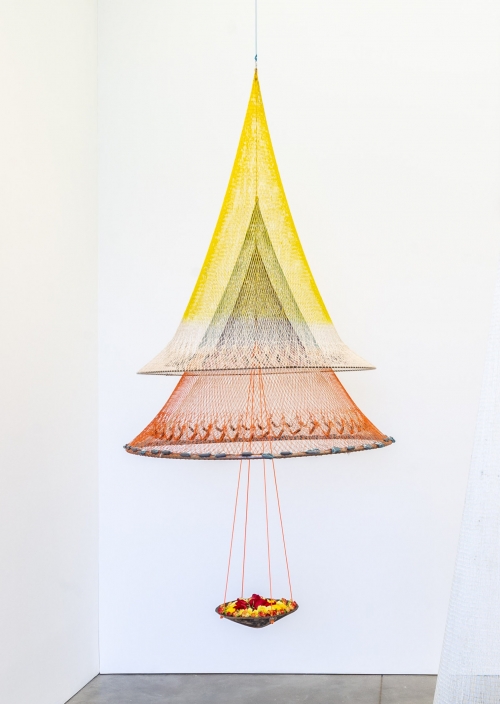
Limen, 2019
Three hand-dyed artisanal fishing nets, lead weights, metal rings, paracord, carved wooden gold pan (batea), and red, yellow, and orange flowers
Collection of Maria and Harry Hopper, Malibu, CA
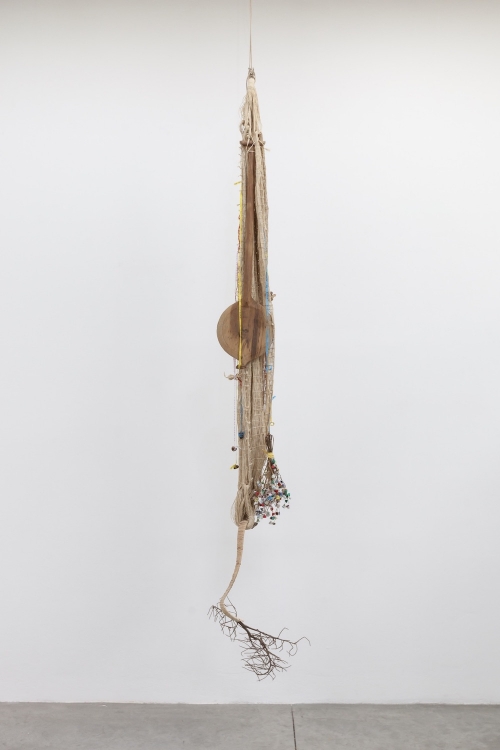
Cosmotarrafa Hamaca, 2016
Artisanal hammock made by the Kayapo people from Para in northern Brazil, dry palm branch wrapped with reed cord, wooden paddle, Bonfim ribbons, and Brazil nuts
Courtesy the artist and Institute deVision, Bogota, Colombia
Nuestro Tiempo/Our Time, 2018
Hand-dyed artisanal fishing net, metal chain, palm mat, wool charm, tambourine, and white flowers
Collection of Tim and Maria Blum, Los Angeles
Currents, Fire and Blood, 2018
Hand-dyed and tar-dipped fishing nets, lead weights, shackles, swivel, thread, paracord, and plastic rope
Promised gift of Steve Corkin and Dan Maddalena
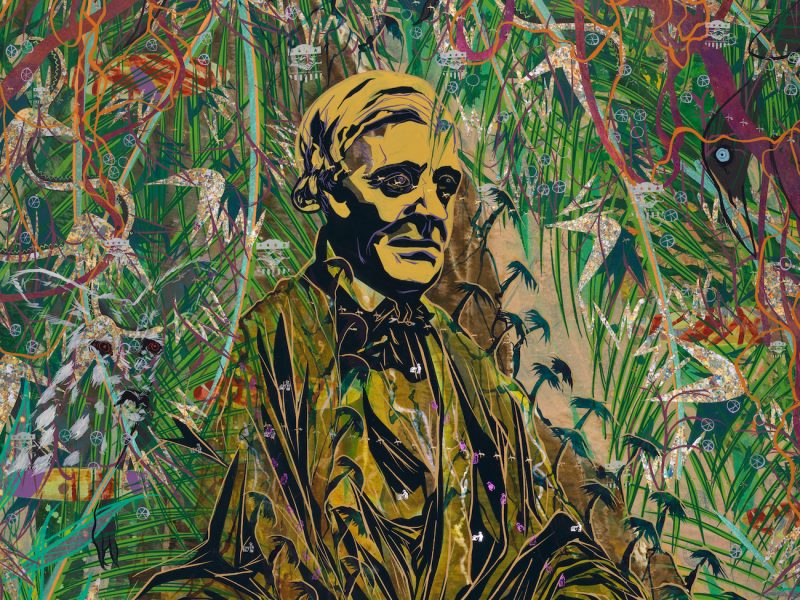
Tammy Nguyen, Ralph Waldo Emerson (detail), 2023. Watercolor, vinyl paint, ink, screen printing ink, pastel, and metal leaf on paper stretched over panel. 100 x 60 inches (254 x 152.4 cm). Courtesy the artist and Lehmann Maupin, New York, Hong Kong, Seoul, and London. © Tammy Nguyen
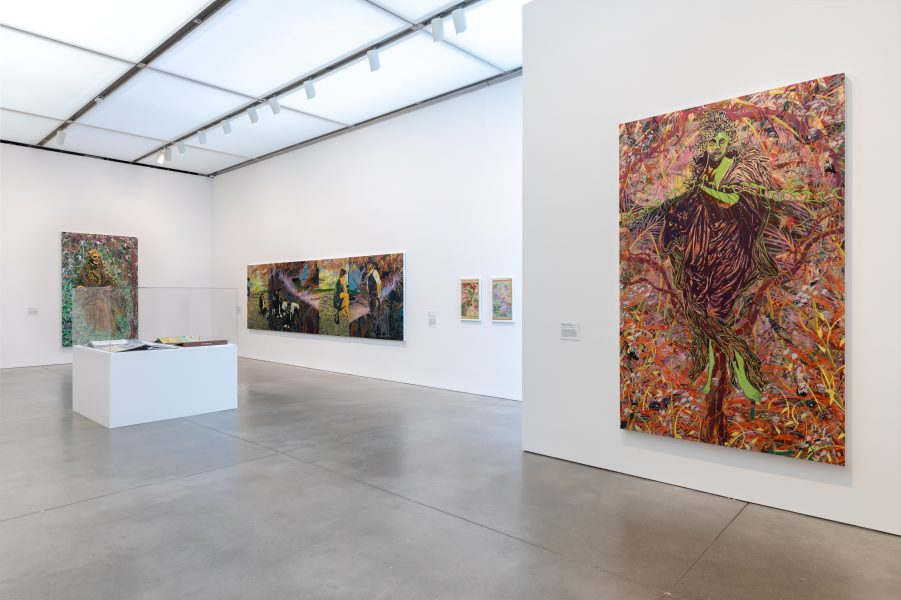
Installation view, Tammy Nguyen, the Institute of Contemporary Art/Boston, 2023-24. Photo by Mel Taing.
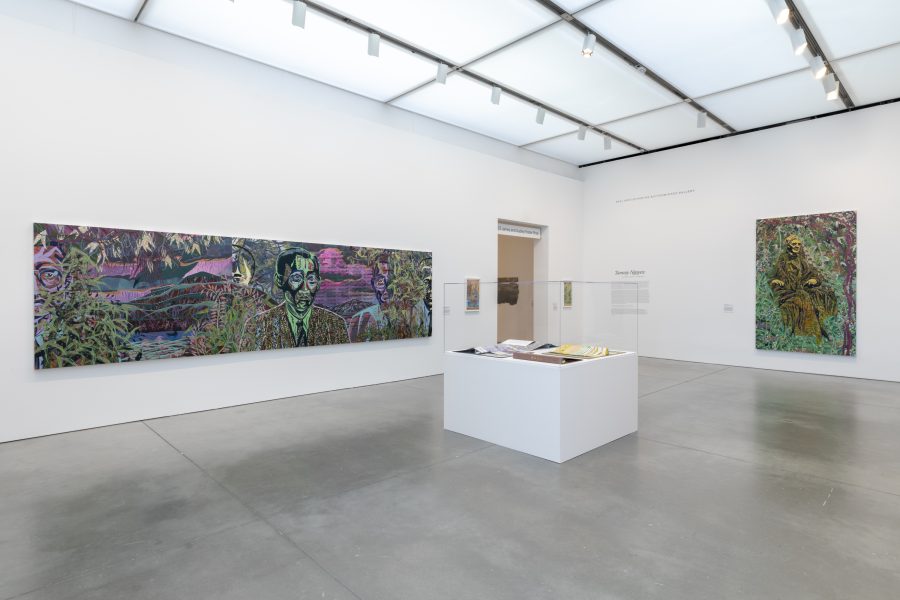
Installation view, Tammy Nguyen, the Institute of Contemporary Art/Boston, 2023-24. Photo by Mel Taing.

Tammy Nguyen, Ralph Waldo Emerson (detail), 2023. Watercolor, vinyl paint, ink, screen printing ink, pastel, and metal leaf on paper stretched over panel. 100 x 60 inches (254 x 152.4 cm). Courtesy the artist and Lehmann Maupin, New York, Hong Kong, Seoul, and London. © Tammy Nguyen

Installation view, Tammy Nguyen, the Institute of Contemporary Art/Boston, 2023-24. Photo by Mel Taing.

Installation view, Tammy Nguyen, the Institute of Contemporary Art/Boston, 2023-24. Photo by Mel Taing.

Tammy Nguyen, Ralph Waldo Emerson (detail), 2023. Watercolor, vinyl paint, ink, screen printing ink, pastel, and metal leaf on paper stretched over panel. 100 x 60 inches (254 x 152.4 cm). Courtesy the artist and Lehmann Maupin, New York, Hong Kong, Seoul, and London. © Tammy Nguyen
Connecticut-based multidisciplinary artist Tammy Nguyen (b. 1984, San Francisco) creates paintings, works on paper, unique artist books, and publications, including through her independent imprint Passenger Pigeon Press. In the densely layered symphonic space of her gilded paintings, Nguyen explores contradiction and confusion through intertwining narratives of geopolitical, environmental, and spiritual subjects. Many of her paintings are composite images that reconsider lesser-known histories against the backdrop of lush landscapes teeming with insects, animals, and plants imbued with agency, and varied symbols of violent conquest or soft power. Throughout, the beautiful aesthetic of Nguyen’s paintings is disarming, creating a productive tension that opens space to consider the histories and subjects her work examines. For the ICA, her first solo museum exhibition in the U.S., Nguyen is creating a new, interconnected body of paintings, works on paper, and artist books. These works, inspired by East Asian landscape painting, are all related to the relationship between man and nature, landscape and wilderness, as articulated in Ralph Waldo Emerson’s influential book-length essay Nature, written in 1836 in Concord, Massachusetts. Nguyen maps the lasting impact of Emerson’s writing on still commonly held ideas about nature and landscape, especially through a studied consideration of land reform programs in Vietnam during the Vietnam War.
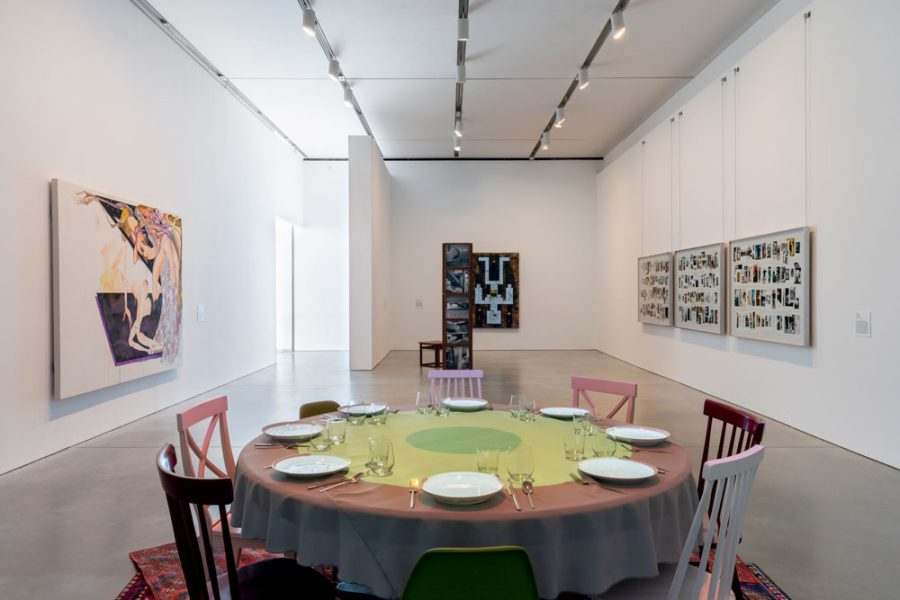
Installation view, New on View, ICA/Boston, 2023. Photo by Mel Taing.
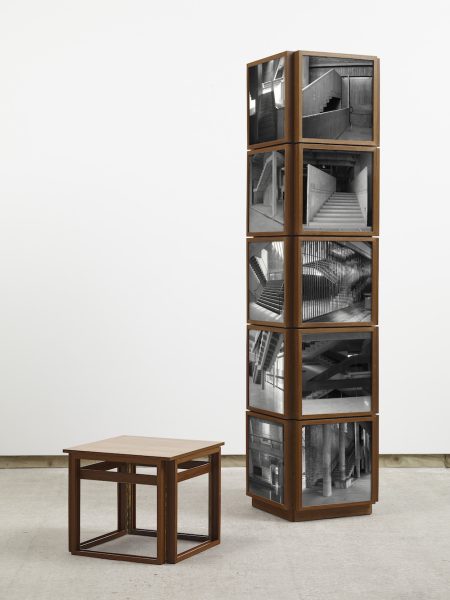
Dayanita Singh, BV Stairs, 2021. Archival pigment prints and wood. Two parts, 89 5/8 × 20 7/8 × 20 7/8 inches (227.5 × 53 × 53 cm) (pillar); 18 1/8 × 21 5/8 × 21 5/8 inches (46 × 55 × 55 cm) (stool). Institute of Contemporary Art/Boston; Promised gift of Kent and Kristen Lucken. © Dayanita Singh

Installation view, New on View, ICA/Boston, 2023. Photo by Mel Taing.

Dayanita Singh, BV Stairs, 2021. Archival pigment prints and wood. Two parts, 89 5/8 × 20 7/8 × 20 7/8 inches (227.5 × 53 × 53 cm) (pillar); 18 1/8 × 21 5/8 × 21 5/8 inches (46 × 55 × 55 cm) (stool). Institute of Contemporary Art/Boston; Promised gift of Kent and Kristen Lucken. © Dayanita Singh

Installation view, New on View, ICA/Boston, 2023. Photo by Mel Taing.

Dayanita Singh, BV Stairs, 2021. Archival pigment prints and wood. Two parts, 89 5/8 × 20 7/8 × 20 7/8 inches (227.5 × 53 × 53 cm) (pillar); 18 1/8 × 21 5/8 × 21 5/8 inches (46 × 55 × 55 cm) (stool). Institute of Contemporary Art/Boston; Promised gift of Kent and Kristen Lucken. © Dayanita Singh
New on View presents a small selection of works on view at the museum for the first time, including several recently acquired works to the permanent collection. Exploring themes such as domesticity and photography in an expanded field, New on View demonstrates that works recently added to the ICA’s collection build on its strengths by taking them in expansive new directions.
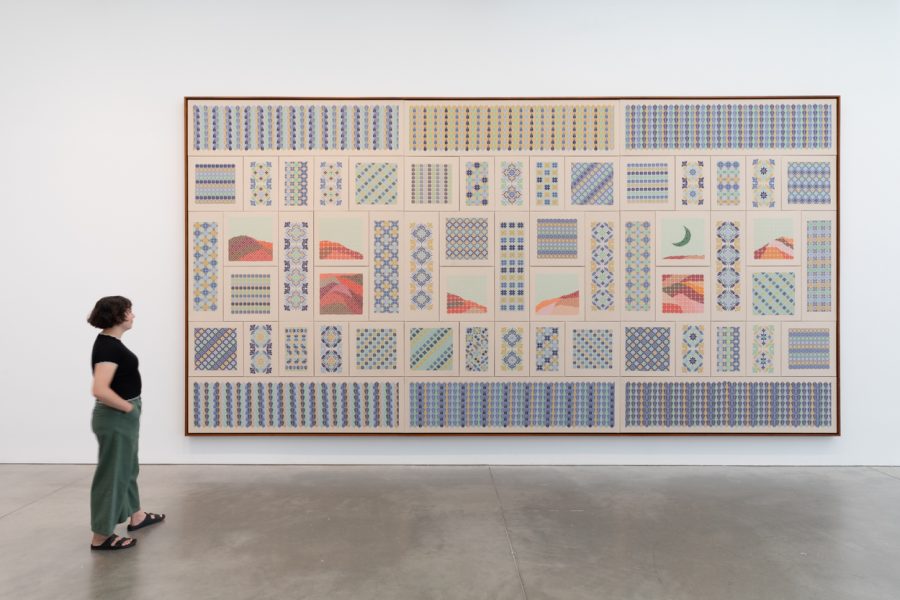
Jordan Nassar, Lament of the Field, 2022. Installation view, Jordan Nassar: Fantasy and Truth, the Institute of Contemporary Art/Boston, 2022–2023. Photo by Mel Taing.
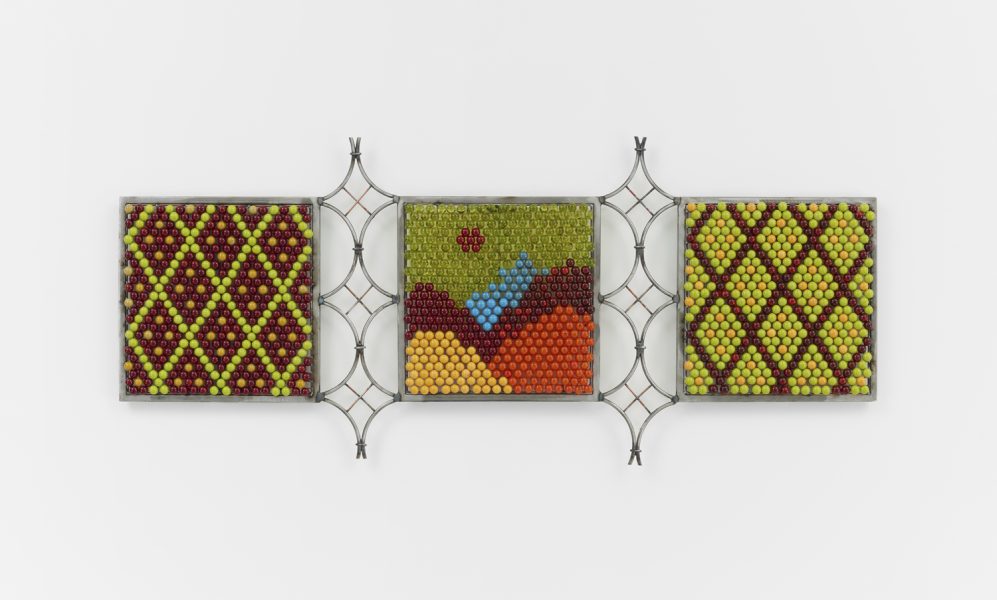
Jordan Nassar, Divorce Of The Doves, 2022. Hand-flamed glass beads, steel, and wire, 21 1/4 × 49 1/4 × 1 3/4 inches (54 × 125.1 × 4.4 cm). © Jordan Nassar. Image courtesy of the artist and James Cohan, New York. Photo by Izzy Leung
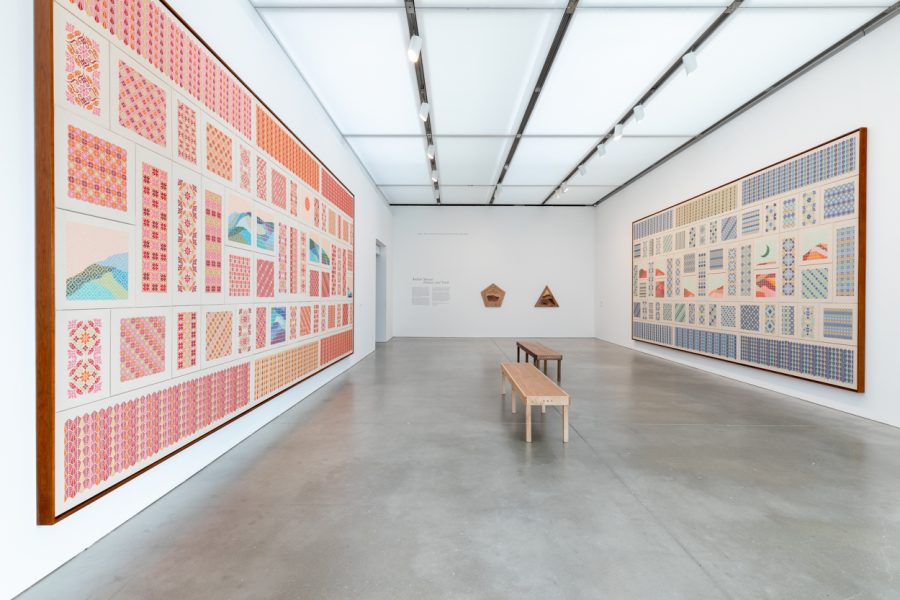
Installation view, Jordan Nassar: Fantasy and Truth, the Institute of Contemporary Art/Boston, 2022-23. Photo by Mel Taing.
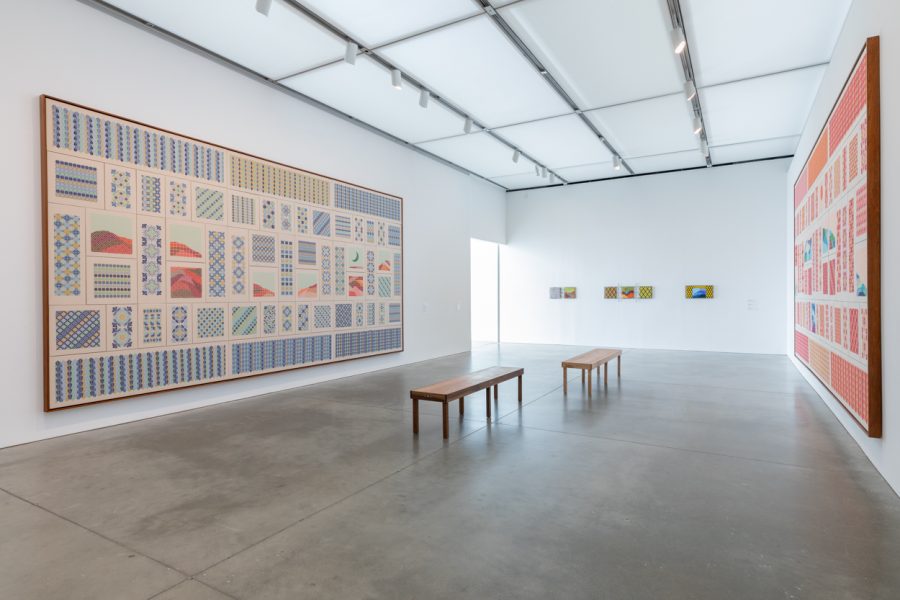
Installation view, Jordan Nassar: Fantasy and Truth, the Institute of Contemporary Art/Boston, 2022–2023. Photo by Mel Taing.

Jordan Nassar, Lament of the Field, 2022. Installation view, Jordan Nassar: Fantasy and Truth, the Institute of Contemporary Art/Boston, 2022–2023. Photo by Mel Taing.

Jordan Nassar, Divorce Of The Doves, 2022. Hand-flamed glass beads, steel, and wire, 21 1/4 × 49 1/4 × 1 3/4 inches (54 × 125.1 × 4.4 cm). © Jordan Nassar. Image courtesy of the artist and James Cohan, New York. Photo by Izzy Leung

Installation view, Jordan Nassar: Fantasy and Truth, the Institute of Contemporary Art/Boston, 2022-23. Photo by Mel Taing.

Installation view, Jordan Nassar: Fantasy and Truth, the Institute of Contemporary Art/Boston, 2022–2023. Photo by Mel Taing.
Jordan Nassar’s solo exhibition—his first in Boston—presents a selection of his intricate embroidered and mixed media works. Nassar (b. 1985 in New York) draws on traditional Palestinian craft techniques to investigate ideas of home, land, and memory. His work, which he creates in collaboration with Palestinian embroiderers and craftspersons, combines geometric patterns with abstracted landscapes, imbued, in the artist’s words, “with yearning, while hopeful and beautiful.” Through complex patterning and a unique attendance to form and color, the painterly aesthetic of Nassar’s embroidery allows the artist to explore relationships between craft and history in new contemporary dialogues.
Jordan Nassar (b. 1985 in New York) is a multidisciplinary Palestinian-American artist who works in traditional Palestinian craft. His embroideries, many of which he creates in collaboration with craftswomen in Ramallah, Hebron, and Bethlehem, combine regional motifs with imagined landscapes. A self-taught artist, Nassar is known for his use of Palestinian tatreez (a form of cross-stitch embroidery), through which colors, patterns, and designs distinguish a wearer both by their origins and their social or familial status, and can signal different stages of life. A thousands of years old tradition, tatreez has strong ties to Palestinian nostalgia, nationality, and heritage.
The two multipanel embroideries exhibited in this gallery, his largest to date, each contain fifty-seven individual panels. The titles — Song of the Flowers (2022) and Lament of the Field (2022) — are pulled from A Tear and A Smile (1914) by Lebanese-American writer Gibran Khalil Gibran (1883–1931), from which the title of this exhibition also draws. Gibran’s melancholic poetics address the ebb and flow of memory, time, and history; similarly, for 4
Nassar, embroidery holds a tension between conflict and harmony in the relationship between stitch and thread, color and pattern. These painterly panoramas fuse complex patterning with close attention to form and color, and appear to exceed the boundaries of their frames to travel across the canvas and beyond it, suggestive of an expansive sky or a boundless horizon.
Throughout Nassar’s work, viewers encounter fragments of landscapes (an experience not unlike memories that fade over time and our collective efforts to recall them). In these imagined geographies, we find relationships that once were and could, perhaps, be again. “I like to discuss these landscapes as versions of Palestine as they exist in the minds of the diaspora, who have never been there and can never go there,” says the artist. “They are the Palestine I heard stories about growing up, half made of imagination. They are dreamlands and utopias that are colorful and fantastical — beautiful and romantic, but bittersweet.”
Song of the Flowers, 2022
Hand embroidered cotton on cotton
Courtesy the artist and James Cohan, New York
Nassar grew up with Palestinian tatreez (a form of cross-stitch embroidery) in his household. After exploring the medium in his artwork for several years, he was introduced to Palestinian embroiderers in the West Bank in 2017. He soon began making works with these women alongside his own embroidery practice. The collaborative works begin with sketched designs Nassar produces in a modular grid. He then sends his sketches to his collaborators in Palestine, who interpret the patterns according to different color schemes, leaving open sections for Nassar. He embeds his own original compositions to finish the embroideries in an act of co-creation.
In recent years, Nassar began working in traditional Palestinian glasswork techniques as well as inlay woodcrafts. To make the glassworks in this gallery, the artist arranged glass beads, which he hand-flamed, onto a steel armature similar to decorative latticework, drawing on techniques of the glass factories of Hebron, a practice dating back thousands of years. In the wood pieces also on display, Nassar creates new sedimented topographies through the layering of natural grains with hand-inlaid brass and mother of pearl; these materials recur in the artist-made benches in this gallery.
Lament of the Field, 2022
Hand embroidered cotton on cotton
Courtesy the artist and James Cohan, New York
Third Family Pentagon, 2022
Spanish cedar, white oak, hemlock, hard maple, Chinese elm, purple heart, figured black walnut, African mahogany, black locust, brass, and mother of pearl
Private collection, courtesy Anat Ebgi Gallery, Los Angeles
Third Family Triangle, 2022
Spanish cedar, Alaskan yellow cedar, black walnut, purple heart, avocado, paradox walnut, sapele, brass, and mother of pearl
Private collection, courtesy Anat Ebgi Gallery, Los Angeles
A Pink Dove Breaks the Cloud, 2022
Hand-flamed glass beads, steel, and wire
Courtesy the artist and James Cohan, New York
Divorce of the Doves, 2022
Hand-flamed glass beads, steel, and wire
Collection of Jody Howard
The Serene Land, 2022
Hand-flamed glass beads, steel, and wire
Private collection, Tunisia